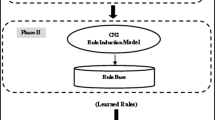Abstract
In intrusion detection, approaches incorporated with data mining become interesting nowadays, in particular the associative classification which is a hybrid technique which uses pruning measure. Although the full rules set is not intended for precise classification, the rules have been used effectively by classifiers that have been built in previous systems. Class detection by variance process uses the association rule mining concept for discovering the association among data variables, and the gained information about different patterns is used to classify the variables into different classes. Using the identified centroids, numerical data is discretized and fed to rule precision index (RPI) classifier for rule induction. Popular Data mining tools operate this technique in the name association based on classification (CBA) which uses confidence as an interest measure for rule pruning. In this work, we present a new interest measure named rule precision index (RPI) which helps us to prune association rules efficiently, and the impact is observed in the classification of attack and non-attack. The resultant associate method produces the best performance among association-based classifiers and is evaluated with conventional classifiers against three different intrusion detection datasets, namely NSL-KDD, CICIDS-2017 and KDD CUP99. The proposed RPI classifier, incorporated with novel interest measure, provides the best accuracy rate of 89.48 % on average than the available classifiers.




Similar content being viewed by others

References
Kumari R, Vashishtha J (2014) Discovery of fuzzy hierarchical association rules. International Journal of Computer Applications 98(19):20–26
Lai X, Liu Q, Wei X, Wang W, Zhou G, Han G (2013) A Survey of Body Sensor Networks. Sensors 13(5):5406–5447. https://doi.org/10.3390/s130505406
K. Vanhoof and B. Depaire (2010) Structure of association rule classifiers: a review. 2010 IEEE International Conference on Intelligent Systems and Knowledge Engineering, pp. 9–12. https://doi.org/10.1109/ISKE.2010.5680784
Liu B, Hsu W, Ma Y (1998) Integrating classification and association rule mining. In: KDD ’98: Proceedings of the fourth ACM SIGKDD International Conference on Knowledge Discovery and Data Mining. ACM Press, pp 80–86
Chien YWC, Chen YL (2010) Mining associative classification rules with stock trading data – a GA based method. Knowledge-based Systems 23(6):605–614
Padillo F, Luna, J & Ventura S(2019) Evaluating associative classification algorithms for Big Data. Big Data Anal4(2). https://doi.org/10.1186/s41044-018-0039-7
Priyanka G, Darshana P, Radhika K (2018) Privacy-preserving associative classification. Springer Book Series on Information and Communication Technology for Intelligent Systems 2(27):246–253
Chen W-C, Hsu C-C (2016) An associative classification approach for enhancing prediction of imbalance data. Proceedings of the Fifth International Conference on Informatics and Applications, Takamatsu, Japan, pp 105–111
Rodda S, Shashi M (2007) An improved associative classifier. International Conference on Computational Intelligence and Multimedia Applications, IEEE Computer Society, India, pp 286–290
Agarwal R, Srikant R (1994) Fast algorithms for mining association rules, vol 1215. Proceeding of Twentieth International Conference on VLDB
Agawal R, Imielinski T, Swami A (1993) Mining association rules between sets of elements in large databases. Proceeding of ACM International Conference on Management of Data, pp 207–216
Brin S, Motwani R, Ullman JD, Tsur S (1997) Dynamic pro-EL set counting and implication rules for market basket data. Proceeding of ACM International Conference on Management of Data, pp 255–264
Shapiro P, Gregory (1991) Discovery, analysis, and presentation of strong rules. Knowledge Discovery in Databases, pp 229–238
Tan PN, Kumar V, Srivastava J (2004) Selecting the right objective measure for association analysis. Journal of Information Systems 29(4):293–313
Siddiqui MK, Naahid S (2013) Analysis of KDD CUP-99 dataset using clustering based data mining. International Journal of Database Theory and Application 6(5):23–34
Bache K, Lichman M (2013) UCI Machine Learning Repository. http:archive.ics.uci.edu/ml
Sharafaldin I, Lashkari AH, Ghorbani AA (2018) Toward generating a new intrusion detection dataset and intrusion traffic characterization. Fourth International Conference on Information Systems Security and Privacy (ICISSP), Portugal
Elhag S, Fernandez A, Altalhi A, Alshomrani S, Herrera F (2019) A multi-objective evolutionary fuzzy system to obtain a broad and accurate set of solutions in intrusion detection systems. Soft Computing 23(4):1321–1336
Wang YJ, Xin Q, Coenen F (2018) Hybrid rule ordering in classification association rule mining. Transactions on Machine Learning and Data Mining 1(1):1–15
Pan S, Morris T, Adhikari U (2015) Developing a hybrid intrusion detection system using data mining for power systems. IEEE Transactions on Smart Grid 6(6):3104–3113
Li L, Yang D-Z, Shen F-C (2010) A novel rule-based intrusion detection system using data mining. Proceeding 3rd International Conference on Computer Science and Information Technology, pp 169–172
Author information
Authors and Affiliations
Corresponding author
Additional information
Publisher’s note
Springer Nature remains neutral with regard to jurisdictional claims in published maps and institutional affiliations.
Rights and permissions
About this article
Cite this article
Sivanantham, S., Mohanraj, V., Suresh, Y. et al. Rule precision index classifier: an associative classifier with a novel pruning measure for intrusion detection. Pers Ubiquit Comput 27, 1395–1403 (2023). https://doi.org/10.1007/s00779-021-01599-0
Received:
Accepted:
Published:
Issue Date:
DOI: https://doi.org/10.1007/s00779-021-01599-0



